
Common sorrel or garden sorrel, often simply called sorrel, is a perennial herb in the family Polygonaceae. Other names for sorrel include spinach dock and narrow-leaved dock. It is a common plant in grassland habitats and is cultivated as a garden herb or salad vegetable.

Yucca is a genus of perennial shrubs and trees in the family Asparagaceae, subfamily Agavoideae. Its 40–50 species are notable for their rosettes of evergreen, tough, sword-shaped leaves and large terminal panicles of white or whitish flowers. They are native to the hot and dry (arid) parts of the Americas and the Caribbean.
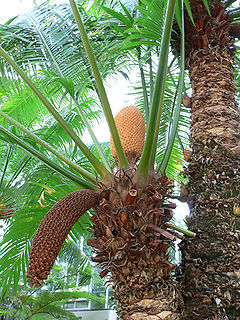
Cycads are seed plants with a very long fossil history that were formerly more abundant and more diverse than they are today. They typically have a stout and woody (ligneous) trunk with a crown of large, hard and stiff, evergreen leaves. They usually have pinnate leaves. The species are dioecious, therefore the individual plants of a species are either male or female. Cycads vary in size from having trunks only a few centimeters to several meters tall. They typically grow very slowly and live very long, with some specimens known to be as much as 1,000 years old. Because of their superficial resemblance, they are sometimes mistaken for palms or ferns, but they are not closely related to either group.
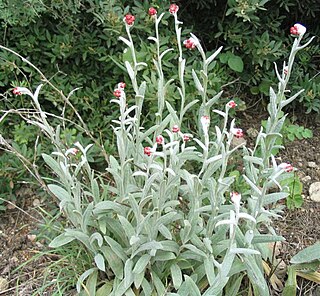
The genus Helichrysum consists of an estimated 600 species of flowering plants in the sunflower family (Asteraceae). The type species is Helichrysum orientale. The name is derived from the Greek words ἑλίσσω and χρῡσός.

Cycadales is an order of seed plants that includes all the extant cycads. These plants typically have a stout and woody (ligneous) trunk with a crown of large evergreen leaves. They usually have pinnate leaves. The individual plants are either all male or all female (dioecious). Cycads vary in size from having trunks only a few centimeters to several meters tall. They typically grow very slowly and live very long, with some specimens known to be as much as 1,000 years old. Because of the superficial resemblance, they are sometimes confused with and mistaken for palms or ferns, but are only distantly related to either.
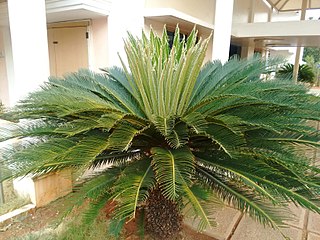
Cycas is a genus of plants belonging to a very ancient lineage, the Cycadophyta, which are not closely related to palms, ferns, trees or any other modern group of plants. They are evergreen perennials which achieved their maximum diversity in the Jurassic and Cretaceous periods, when they were distributed almost worldwide. At the end of the Cretaceous, when the non-avian dinosaurs became extinct, so did most of the cycas in the Northern Hemisphere.

Cycas revoluta, is a species of gymnosperm in the family Cycadaceae, native to southern Japan including the Ryukyu Islands. It is one of several species used for the production of sago, as well as an ornamental plant.

Epilobium is a genus of flowering plants in the family Onagraceae, containing about 197 species. The genus has a worldwide distribution. It is most prevalent in the subarctic, temperate and subantarctic regions, whereas in the subtropics and tropics Epilobium species are restricted to the cool montane biomes, such as the New Guinea Highlands.
Sago palm is a common name for several plants which are used to produce a starchy food known as sago. Sago palms may be "true palms" in the family Arecaceae, or cycads with a palm-like appearance. Sago produced from cycads must be detoxified before consumption. Plants called sago palm include:

Osteospermum moniliferum(Chrysanthemoides monilifera) is an evergreen flowering shrub or small tree of the Asteraceae (daisy) family that is native to South Africa, such as the Cape Flats Dune Strandveld habitat. Most subspecies have woolly, dull, serrate, oval leaves, but the subspecies rotundata has glossy round leaves. Subspecies are known as boneseed and bitou bush in Australasia, or bietou, tick berry, bosluisbessie, or weskusbietou in South Africa. The plant has become a major environmental weed and invasive species in Australia and New Zealand.

Cycas armstrongii is a species of cycad in the genus Cycas, endemic to Northern Territory of Australia. It is found from the Finniss River in the west to the Arnhem Highway in the east, north of Pine Creek. It also occurs on the Tiwi Islands and the Cobourg Peninsula
Cycas arnhemica is a species of cycad in the genus Cycas, native to Australia, in the northwest of Northern Territory in Arnhem Land, after which it is named.

Cycas beddomei is a species of cycad in the genus Cycas, native to India, where it is confined to a small area of Andhra Pradesh state in the Tirumala Hills in scrubland and brush covered hills.
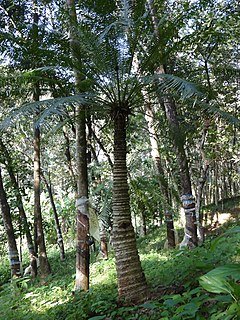
Cycas circinalis, also known as the queen sago, is a species of cycad known in the wild only from southern India. Cycas circinalis is the only gymnosperm species found among native Sri Lankan flora.

Cycas micronesica is a type of cycad found in the island of Yap in Micronesia, the Marianas islands of Guam and Rota, and The Republic of Palau. It is commonly known as Federico nut or Fadang in Chamorro. The species, previously lumped with Cycas rumphii or Cycas circinalis, was described in 1994 by Ken Hill. Paleoecological studies have determined that C. micronesica has been present on the island of Guam for about 9,000 years. It is linked with the human degenerative disease Lytico-Bodig disease, which is similar to amyotrophic lateral sclerosis (ALS) through a neurotoxin (BMAA) in the seeds, which were a traditional food source on Guam until the 1960s.
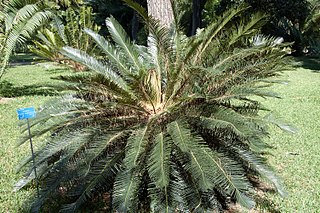
Cycas taiwaniana is a species of plant in the genus Cycas. The species is native to Guangdong, Guangxi and Fujian in China. Although the specific epithet, taiwaniana, is derived from Taiwan, where the original type specimens were found, it is not naturally distributed in Taiwan. Instead of C. taiwaniana, the original type specimens used for describing C. taiwaniana, had been reclassified under another species, Cycas taitungensis.

Cycas taitungensis is a species of genus Cycas endemic to Taitung County, south-eastern Taiwan. C. taitungensis, an evergreen tree, can grow up to about 5 m (16 ft) tall. The species was not described until 1994, but its specimen was once applied as the type of species Cycas taiwaniana, which is not really distributed in Taiwan according to the further research.

Cycas rumphii, commonly known as queen sago or the queen sago palm, is a dioecious gymnosperm, a species of cycad in the genus Cycas native to Indonesia, New Guinea and Christmas Island. Although palm-like in appearance, it is not a palm.

Cycas thouarsii, the Madagascar cycad, is an evergreen arborescent cycad in the genus Cycas. It is named after a French botanist Louis-Marie Aubert du Petit-Thouars (1758—1831).

Cycas riuminiana, commonly known as the Arayat pitogo or simply pitogo, is a species of cycad endemic to Luzon, Philippines. It is also locally known as bayit in Tagalog and sawang in Ilocano, among other names.


















